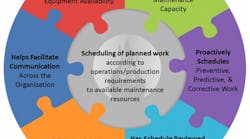Several factors contribute to lackluster wrench time, including waiting on parts and materials or unexpected travel. Planning and scheduling maintenance can help alleviate this issue. A company that is properly planning and scheduling its work can see wrench time increase to 60 or 80%.
One of the most effective ways to improve plant maintenance operations and improve wrench time is to streamline your organization’s planning and scheduling work order processes. To reach optimization, you need a solid foundation of collective plant maintenance knowledge along with communication and accountability across departments. It’s no surprise that plant maintenance planning and scheduling is a not a one-size-fits-all model.
Optimized planning and scheduling is a process that doesn’t happen overnight. It depends upon a few factors, including the manufacturing organization’s size; the relationships between maintenance, production, and procurement groups; and reversing the reactive work mode. There are a number of reasons to optimize your organization’s planning and scheduling practices, including:
- efficient plant maintenance practices enable resources to achieve more with less
- proactive scheduling of production processes reduces equipment failures and helps to ensure that plant maintenance work is planned, aiding in work orders being completed according to priorities and synchronized with production schedules.
Being proactive
Plant maintenance planning and scheduling helps alleviate reactive situations such as when a rush priority job loses its urgency after materials arrive on location. With a real-time work order scheduler, you will have the knowledge and ability to communicate immediately with multiple departments, such as production, in order to reallocate resources to other jobs.
Proper plant maintenance planning and scheduling also eliminates the need for your company to hold an excess surplus of parts and tools in inventory and allows you to cancel requests for permits that are no longer needed. Having visibility into the in-house inventory will enable you to use parts and tools now freed up from previous work orders on future work orders. Also being able to search on long text to find parts required for a repair greatly limits the occurrence of free text input. And with all departments using the same real-time tool, you can quickly and easily schedule jobs and coordinate and minimize downtime with production.
With the right solution and efficient coordination of available materials, tools, and resources, your company can improve workflow and save time and money.
Planning and scheduling benefits
How do you begin to effectively plan and schedule plant maintenance resources for your company? You should start by evaluating current plant maintenance processes. From there, you can implement a program that allows you to collaborate with all departments and allocate resources according to work order requirements. Considerations when using a scheduling process include the following.
Scheduling workers
- Planning jobs in advance
- An effective planner uses task lists and bills of materials (BOMs), resulting in quicker and more informed planning, which leads to an increase in worker productivity, also known as wrench time (Figure 1).
- Arranging for parts and permits to be ready when needed
- An effective scheduler helps ensure that equipment, permits, tools, and material are available for workers before any job starts (Figure 2).
- Retaining knowledge
- A proven planning and scheduling platform gives workers across all departments access to the same work order flow best-practice methods, preventing loss of knowledge when a senior worker retires or leaves the company.
Scheduling equipment
- Scheduling jobs and coordinating schedules with production
- An effective scheduler evaluates existing maintenance practices and creates standardized processes and workflows, achieving top-to-bottom organizational support and buy-in.
- Coordinating availability of assets
- An effective scheduler helps ensure that permits, rental equipment, tools, and materials are in place and available before any job starts.
- A published maintenance schedule overcomes a lack of transparency and allows workers to know what they need before they need it, which increases wrench time.
Figure 1. An effective planner uses task lists and bills of materials (BOMs), resulting in quicker and more informed planning, which leads to an increase in worker productivity, also known as wrench time.
Figure 2. An effective scheduler helps ensure that equipment, permits, tools, and material are available for workers before any job starts.
Conclusion
Effective planning and scheduling of plant maintenance resources helps improve strategies for preventive maintenance and asset care. An effective best-in-class plant maintenance planning and scheduling solution can help increase worker productivity, ensure knowledge transfer between the experienced workforce and new hires and become an enabler for cross-functional collaboration.
| Rick Taylor is the UK Managing Director at Prometheus Group. Contact him at [email protected]. |
Centralizing your plant maintenance scheduling activities through a comprehensive solution can help save time and effort because you can, for example, visually organize all project scheduling, take advantage of a project overview map, and reduce the amount of overlooked or lost orders through accurate reports.
In addition, you will enable more efficient work at a lower cost to the company. Planning and scheduling increases efficiency and worker productivity by allowing you to schedule parts, tools, permits, and maintenance time. By using standards, you help ensure consistency across the board, thereby increasing the bottom line.
